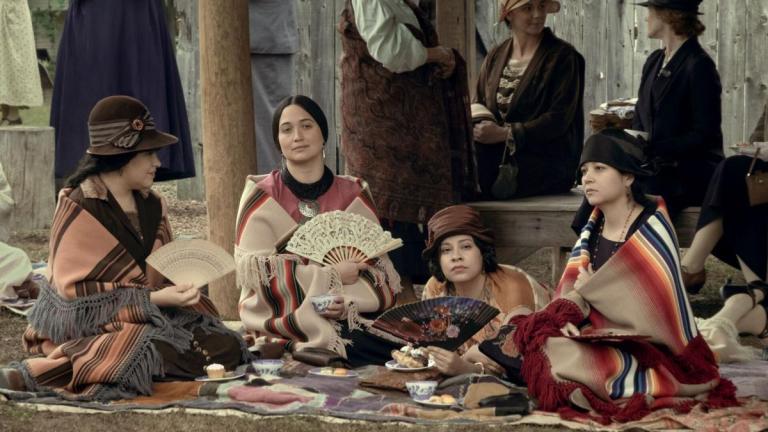Killers of the Flower Moon’s Missed Opportunity: Not Centering Mollie Burkhart’s Story
Martin Scorsese’s Killers of the Flower Moon is a sprawling epic about the legacy of American greed, but its attentions are divided.

This article contains Killers of the Flower Moon spoilers.
Martin Scorsese’s Killers of the Flower Moon is a towering achievement in moviemaking, one which has lingered in my memory for over a week. The storied filmmaker’s expansive vision of the Osage murders, which were perpetrated between the 1910s and ‘30s, is brutal, unflinching, and ultimately haunting. It is difficult to think of a film that better encapsulates the almost industrialized manner in which American racism is harnessed to create cold hard cash for the greediest and cruelest who nestle at the top of white privilege.
Yet I’ve struggled to use the word “masterpiece” while writing about the film, either here or in my review. Many colleagues have already supplied that loaded term to the film’s marketing campaign, placing the picture along the same pantheon of other Scorsese masterworks about bad men who do bad things before (sometimes) reaping the whirlwind: Goodfellas. Raging Bull. The Wolf of Wall Street. On a certain level, Killers of the Flower Moon is their successor. However, this realization also belies the film’s one great weakness: It really wasn’t their story to tell. It was Mollie Burkhart’s, who is played luminously by Lily Gladstone in the film.
This will likely be a dialogue which grows after more folks see the film in the coming weeks and months—including past what is sure to be a contentious awards season. It has in fact already started with Christopher Cote, an Osage language expert on Killers of the Flower Moon, giving a poignant and candid answer to THR on why he has complicated feelings toward the finished film.
“I was nervous about the release of the film,” Cote said. “Now that I’ve seen it, I have some strong opinions. As an Osage, I really wanted this to be from the perspective of Mollie and what her family experienced, but I think it would take an Osage to do that. Martin Scorsese, [while] not being Osage, I think did a great job representing our people, but this history is being told almost from the perspective of Ernest Burkhart, and they kind of give him this conscience, and they kind of depict that there’s love [in him]. But when somebody conspires to murder your entire family, that’s not love. That’s not love. That’s just beyond abuse.”
It’s a provocative comment, and one I mostly agree with despite recognizing the film to be an immense cinematic work. One suspects Scorsese is aware of this too since the nearly three and a half hour film avoids making Leonardo DiCaprio’s Ernest Burkhart the full protagonist. But that’s because Killers of the Flower Moon doesn’t really have one. It is a tapestry of victims and victimizers, exploiters and the exploited, Indigenous people and the white faces who murder them. As a consequence, the scope of the film is vast, and honestly a little indulgent in its unwieldiness. This problem could’ve been avoided or mitigated if the film recognized Mollie, and not her husband, needed the best scenes. Yet for large chunks of the middle of the film, we focus on Ernest’s guilt as he slowly poisons his wife, instead of on Mollie’s dawning awareness of treachery.
To be clear, Gladstone is remarkable in the film. A quiet but irrepressible presence in most of her scenes, Gladstone’s Mollie is a laconic woman whose strong will nonetheless dominates every room. Whether Ernest really began pursuing Mollie out of natural interest or because he was encouraged to by his uncle, the reptilian William Hale (Robert De Niro), is ultimately unknowable. It also doesn’t matter given what Ernest did. But the film avoids the question altogether, preferring instead to focus on Gladstone in the courtship scenes. She brings such a disarming playfulness that when she asks Ernest to share some whisky with her, she might as well be telling DiCaprio to prepare to cede the audience’s attention.
Intriguingly, however, DiCaprio was not originally intended to play the man who betrayed Mollie on every moral, ethical, and ultimately intimate level. He was initially pegged by Scorsese to play Tom White, the incorruptible and old school cowboy who in the FBI’s nascent, primordial days might’ve been the first white man to step foot in the Osage Hills without ill-intent for the Native Americans who lived there.
For the record, such a depiction of White is accurate to the history of the Osage murders, and it is one of the defining aspects of the nonfiction book by David Grann on which Killers of the Flower Moon is based. However, that story is structurally a yarn we’ve seen Hollywood eagerly recite decade after decade, even when it was at odds with the actual history of the subject matter, such as Mississippi Burning egregiously crediting the FBI with the success of the Civil Rights movement, or The Help’s story still being told from the perspective of wealthy white patrons.
Perhaps that’s why, according to Scorsese, two years into the process, DiCaprio asked what the hell kind of movie they were trying to make. The filmmaker recently reiterated those details in an interview with The Irish Times where the director said, “Myself and Eric Roth talked about telling the story from the point of view of the bureau agents coming to investigate. After two years of working on the script, Leo came to me and asked ‘Where is the heart of the story?’ I had meetings with the Osage, and I thought, ‘Well, there’s the story.’ The real story, we felt, was not necessarily coming from the outside, with the bureau, but rather from the inside, from Oklahoma.” By choosing to abort the FBI procedural framing, Scorsese and DiCaprio even lost Paramount Pictures as a backer. The studio didn’t want to invest in a film focused on white men murdering brown people, many of them women.
Scorsese and DiCaprio’s impulse was a wise one, and made for a better film. And yet, we would argue they still couldn’t resist letting this story of heinous betrayal be primarily told from the vantage of yet other white men—just the type no one would dare call a savior.
Killers of the Flower Moon begins with a provocative sequence of the day Osage workers discovered oceans of oil beneath their land in 1901. So it does start with the native perspective, which carries through as it tracks newsreels and pseudo-silent movie title cards which tell the audience about the amounts of wealth the Osage accrued by the 1920s. However, the first major character we meet in the film is DiCaprio’s Ernest, not an Osage person, and we watch his earliest scenes with Mollie largely from his point-of-view.
For much of Killers’ runtime, the narrative is shared between DiCaprio and Gladstone, as well as De Niro. But the choice to attempt to tell all perspectives in what amounts to a sinister conspiracy of diabolical murder undermines the tale’s full power.
Much of the publicity for the film has emphasized how Grann’s book puts heavy emphasis on Tom White, which is true. However, the entire first section of the book is from the narrow point-of-view of Mollie Burkhart. She is a proud woman who married a handsome white devil named Ernest, and as far as she (and the reader) can tell, he is working diligently by her side to discover who is killing her family. One by one her sisters die: of illness, of a gunshot murder, and finally by a blatant act of terrorism when a bomb is placed under the house of Reta (JaNae Collins) and Bill Smith (Jason Isbell). The horror of the book is that a reader unfamiliar with the Osage murders learns as slowly and despairingly of the breadth of this conspiracy as Mollie did, with the final nightmare being that Ernest was in on it all along.
Frankly, we imagine that approach could still be the basis of a film where the role of Tom White (who was ultimately played by Jesse Plemons) remains secondary, albeit such an angle might not leave a role as plum as the Ernest Burkhart that’s created by DiCaprio.
The truth is we do not know what lies in the hearts of men. One of the reasons the feds were able to bring Hale down—albeit he only served 20 years of his life sentence—is because Ernest’s conscience grew guilty enough for him to cave to the prosecution. He was likely a man wracked with regrets and shame. Restructuring the story so that sense of inner turmoil and self-loathing is front and center can obviously work—Scorsese and his co-screenwriter Eric Roth mined great drama out of it for DiCaprio to play. Nonetheless, the effect is a bit like if Gaslight was more about Charles Boyer’s moments of self-doubt instead of Ingrid Bergman’s growing sense of doom as her husband attempts to put her into an early grave.
Mollie is the closest thing Killers of the Flower Moon has to a hero. She brings in private detectives when William Hale and the local officials conspire to do nothing about the murders they’ve sanctioned; when that fails she goes to Washington D.C. herself, even as she is dying because of the poisoned medicine Ernest gave her. It’s the last act of desperation to get the white government to do something about the murders.
In the end, she is the one who is forced to see her spouse for who he really is. Gladstone and DiCaprio are each devastating when she asks him, at last, what was in the shots he administered to her. By that point in the film, Mollie and Ernest have gone through so much, but never as a united couple. And now that a daughter has died between them, while Ernest wastes away in a jail cell, their estrangement is total. But the fact the film spends more time on Ernest’s reaction to losing the little girl than to Mollie’s underscores the film’s divided and ultimately contradictory attentions.
Scorsese rightly wants to keep the Osage at the center of his story, even refusing in the last scene to dramatize Ernest and Hale’s final fates; he leaves their ignominious ends to the dustbin of history while focusing on the lives of the Osage who survived Hale’s Reign of Terror, a terror that Ernest was indispensable in implementing. But whether by virtue of his own cinematic interests or the concerns of his cast, Scorsese’s Killers struggles at keeping the Osage at its core. Instead it’s often a picture about the evil men do to each other and their own souls.
Despite that, the film does have a purer soul and it belongs to no white man, nor a figure of doom and damnation. Her name is Mollie, and a great film could’ve been a masterpiece if she didn’t have to take turns sharing her story.
